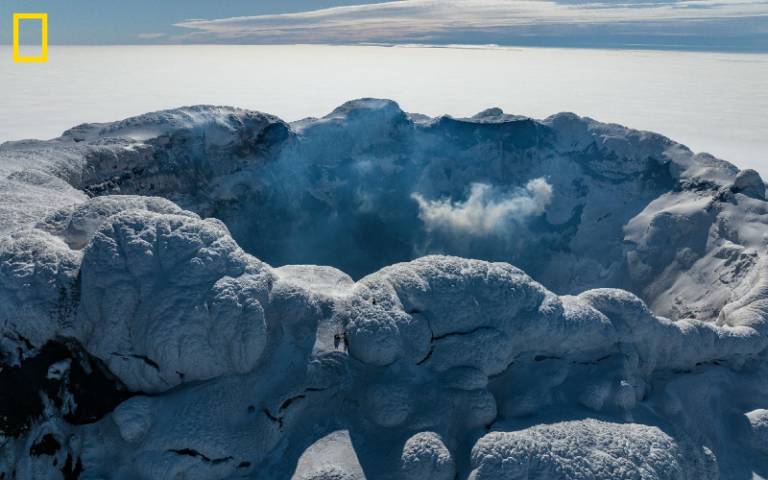A team led by Dr Emma Nicholson climbed the summit of an active volcano on a remote, sub-Antarctic island, confirming the existence of a lava lake within its crater. Now they're back, analysing their data to better understand volcanoes and their environmental impacts.

Mount Michael is a volcano shrouded in mystery. Only a handful of people have ever landed on the remote Saunders Island it sits atop, and before the expedition led by Dr Nicholson (UCL Earth Science), no one had ever scaled the summit. The few glimpses from space that have slipped through the almost constant cloud cover have tantalised volcanologists.
"It's been known for several decades now that Mount Michael hosts a persistent thermal anomaly at its summit. A hotspot much hotter than the surrounding area," Dr Nicholson said.
"We know from other 'open vent' volcanoes around the world that host these hotspots that they often have active lava lakes within their summit craters."
Stable lava lakes are a rare geologic feature. They need a careful balance between the heat supplied by gas and magma from deep in the Earth and heat loss at the surface to remain molten. Out of about 1,500 active volcanoes on Earth, only seven have currently or recently hosted one, and Nicholson and her team wanted to confirm suspicions that Mount Michael was home to the eighth.
Mount Michael's remote location and continuous outgassing also makes it an ideal natural laboratory to study how the volcano's emissions affect the local environment. The island's nearest inhabited neighbours are the Falkland Islands more than 1,200 miles away.
"Very few other places have such a pristine environment where you know that every trace metal that you sample in the environment has come from the volcano," Dr Nicholson said.
The team had hoped to use some of the island's untouched snowfall for drinking water. However, when they tested some of the nearby snowpack, they found it was deeply acidic and completely undrinkable, a clue to how much the volcano was affecting the island's environment.
"I had expected there to be some interaction, but I never expected it to be this strong, so suddenly that became a major research focus," Dr Nicholson said.
Saunders Island is part of the South Sandwich Islands, a volcanic archipelago stretching across about 200 miles of the Southern Ocean. These kinds of island arcs are found around the world and form where two of Earth's tectonic plates collide and one is forced under the other.
"It's really a window into the development of more mature arcs," Dr Nicholson said. "The whole island arc itself is incredibly interesting because geologically it's one of the youngest volcanic arcs on Earth."
Island arcs like these are home to millions of people around the world. As well as shedding new light on how volcanic arcs develop over geological time, the team hopes that the lessons learned here will contribute to improving eruption forecasts and monitoring capabilities at volcanoes in populated areas.
Many weeks of lab work






